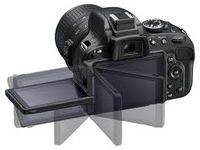In Studio Video Capture Process - Using the DSLR
Contents
Setting up the DSLR to record video
DO NOT use the lens to hold the camera.
As a safety precaution, put the strap around your head, or wrist when holding the camera by the base or right-side grip.
Flip the viewing screen
On the 60D model, the viewing screen can be used flipped out, flipped over, used at an angle or returned to the back of the camera facing outward. (n/a on the 7D camera)
Exposure control
The Exposure control dial should be set to the Video Camera Icon. (click on the photo for a larger view)
Formatting the SD card
Click this link for a short YouTube tutorial - Formatting an SD card
- - Press the Play button, a blue triangle icon to the lower right of the screen.
- - The screen should display the message "No image."'
- - If there are still files on the card, make sure that they have been downloaded to the current working drive. If they have not, then please transfer them before formatting the card. If they have been transferred, proceed with formatting the card.
- - DO NOT turn off the camera while it is formatting.
Settings
Make sure that these camera settings are enabled
- - AWB (Auto white balance)
- - 60 fps "(frames per second)
Tripod mounts
Tripod mounting plates should be on the camera(s), with the small nut facing towards the lens.
- - Lock down the tripod tilt and tighten the handles. Set up the camera on the tripod making sure that mount locks. Start with locking mechanism open, feed plate into the side opposite the locking mechanism under top and bottom guides. Press firmly onto lock, and it should snap shut. DO NOT leave camera on tripod without being sure it is securely mounted with all adjustments tightened.
Rules of good DSLR shooting technique
- Make each camera angle unique and avoid mirroring the same angle as the DSLR shots.
- Use the GoPro cameras to cover wide shots, profiles or shots that include multiple band members. If possible, use one GoPro camera to capture a wide shot of the entire band.
- Place the camera that you'll move on a tripod in a centralized location, providing an easy line of sight to each member of the band.
- Most camera angles should be at eye level with the person being shot, however there are always exceptions.
- -Please be aware that shooting a subject from below may provide a clear view up into his/her nose, and may also accentuate any double chins.
- - Shots from above must be carefully composed to avoid looking like surveillance camera footage.
- When shooting, keep an eye on what is happening outside of the camera's view. Look around and observe what is happening in the performance. Is there a guitar solo coming up? The idea of "show me what I'm hearing" should be your guide for DSLR closeups. You can request a headphone feed of the full mix from the audio engineer to better hear the action.
-At all times you should have one hand on the tripod handle and one hand focus/zoom rings of the lens.
- While shooting, you must constantly check to make sure that the camera is in focus. A tiny difference in the focus can dictate the difference between a usable and an unusable piece of footage.
- The general rule for shooting close ups is to set up the shot and stay on to it for as long as you can - NEVER less than 5 seconds. Keep in mind that not leaving enough time on a shot will result in that shot being unusable.
- The bulk of your DSLR footage will focus on lead vocals and instrumental solos, but try to get a decent medium shot of each member in the band during each song.
- Avoid framing subjects at their joints, i.e., shoulders, at the waist, at the knees.
- DSLR close ups should be used to add emotion and character to a session, not used as the main image source for the finished video.

